U.S. Crop Protection Chemicals Market Size
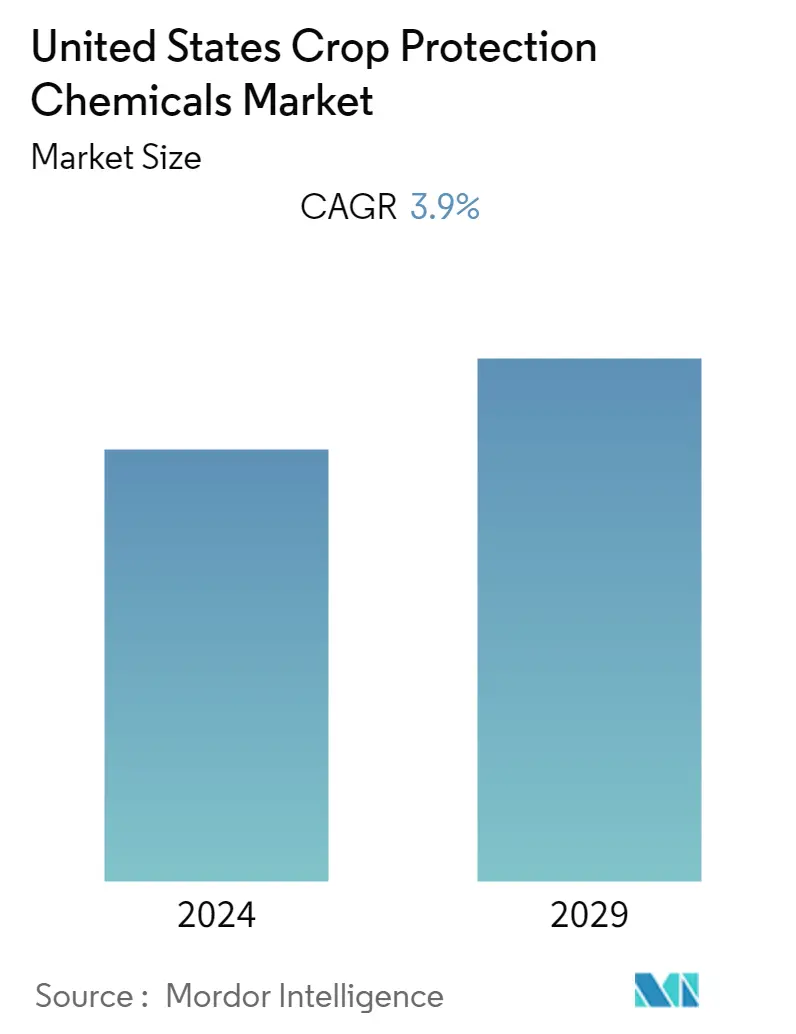
| Study Period | 2018 - 2028 |
| Base Year For Estimation | 2022 |
| Forecast Data Period | 2024 - 2028 |
| Historical Data Period | 2018 - 2021 |
| CAGR | 3.90 % |
| Market Concentration | High |
Major Players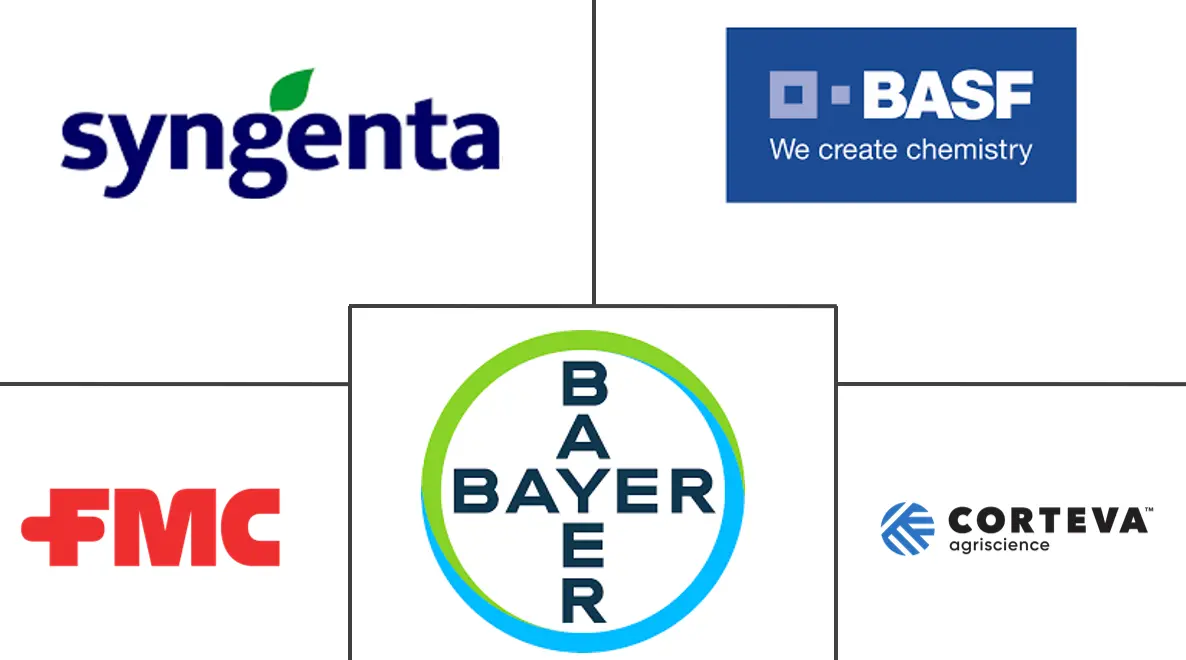
*Disclaimer: Major Players sorted in no particular order |
Need a report that reflects how COVID-19 has impacted this market and its growth?
U.S. Crop Protection Chemicals Market Analysis
The United States Crop Protection Chemicals Market is projected to register a CAGR 3.9% during the forecast period.
- The crop protection chemical industry has been transforming over the years, with robust growth coupled with changing crop mix trends and environmental regulations. Growing population, declining arable land, food security, and the need for augmented agricultural productivity are the significant factors driving the demand for higher agricultural output, thus augmenting the growth of the crop protection industry in the country.
- The most important crop grown in the United States is corn. However, it must contend with several disease threats throughout its life cycle, including common and southern rust, grey leaf spot, northern corn leaf blight, and stalk rot. Early disease management is critical for keeping the crop healthy and producing high yields. According to the Crop Protection Network (CPN), the disease reduced corn production in the United States by 3.9% in 2020. In 2020, Fusarium stalk rot was the most damaging disease in the United States, which caused by a variety of Fusarium fungi pathogens. The shredded pith on the affected plants ranges in color from whitish-pink to salmon.
- According to the US Department of Agriculture (USDA), soybeans had the highest rate of insecticide application. The farmers in Minnesota primarily use neonicotinoids and chlorpyrifos as insecticides. However, due to growing concerns about the harmful effects of synthetic insecticides, the state government restricted the use of neonicotinoids, primarily to ensure the permissible use of the bee-harming insecticide.
- Crop protection chemicals are in high demand in the United States due to an increase in pests and diseases on commercial crops. As a result, the crop protection chemicals market is expected to expand during the forecast period. For instance, as per the USDA report, Aphid infestations reduced the yield by reducing the number of pods, the number of seeds, and the oil content of the seeds. Disease accounted for 5.0% of soybean production potential in 2020. Soybean cyst nematode, seedling diseases, root-knot nematode, and Sudden death syndrome are the most damaging diseases, causing 2.4 million metric ton of damage, 0.6 million metric ton of damage, 0.3 million metric ton of damage, and 0.5 million metric ton of damage, respectively.
U.S. Crop Protection Chemicals Market Trends
Increasing Focus Towards Sustainable Crop Production
Growing concerns about personal health have led consumers to invest in organic products and to try new ones. The health implications associated with organic foods have become more important than ever as people look for ways to find overall wellness.
Due to the growing demand for food safety and quality, biopesticides are gaining increasing popularity in sustainable agriculture. The biopesticide sector has been driven by a growing awareness of sustainable food production, farmers' concerns about excessive chemical use, and the rising expense of chemical crop protection. According to the US Environmental Protection Agency (EPA), microbial pesticides accounted for around seven of the total biopesticides registered in the United States by the end of 2020. The large number of microbial pesticides registered in the country indicates a huge demand for these products.
Many government associations are coming up with sustainable programs for the development and implementation of biopesticides as part of integrated pest-management programs. The Forest Health Assessment and Applied Sciences Team (FHAAST) Biopesticides Program serves as an up-to-date information source on biopesticides, biologically based products such as semiochemicals and microbial agents, used by State and Private Forestry staffs, nationwide, for short-term control of invasive species.
In addition, some market players are involved in the production of environment-friendly bio-based crop protection chemicals. This would lead to an increase in the use of crop protection products by customers to produce organic crops and keep a balance with the environment. According to the USDA, the United States was a major exporter of organic commodities with the highest percentage for lettuce, apples, and grapes, in 2020. Multiple nematodes (roundworms), such as root-knot, cyst, sting, and lance, prevalent in a wide range of crops grown organically are expected to push the demand for bio-nematicides.
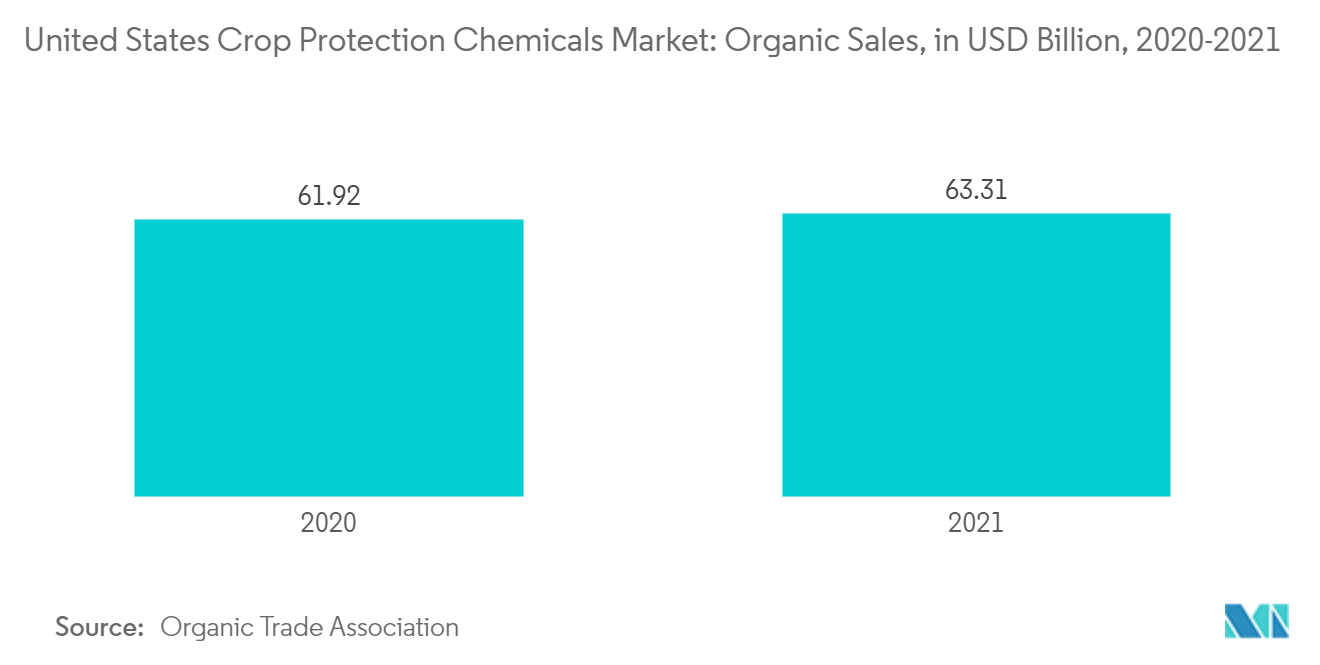
Herbicides Dominates the Market
Herbicides are chemical agents that are used to kill or inhibit the growth of unwanted plants, such as weeds in the home or on the farm, and invasive species. Chemical herbicides have a significant advantage over mechanical weed control in terms of ease of application, which often saves labor costs.
Glyphosate, 2,4-D, atrazine, glufosinate-ammonium, paraquat, pendimethalin, dicamba, fluroxypyr, and metolachlor are the commonly used synthetic herbicides. However, glyphosate is the primary driver of market growth. Glyphosate, sold under the brand name Roundup by Bayer, is the most widely used herbicide. It is a broad-spectrum, non-selective, systemic herbicide that accounts for 60% of the global market for non-selective herbicides. However, due to serious health concerns and the substance's carcinogenic nature, many states, European Union (EU) and many other countries worldwide have prohibited glyphosate. Many herbicides that are still widely used in the United States, in quantities ranging from tens to hundreds of millions of pounds per year, have been banned or are being phased out.
Bio-herbicides that use microbes as biological weed control agents are gaining popularity in integrated pest management techniques, along with synthetic herbicides. Although the segment constitutes only a small part of the industry, it is expected to grow at a significant rate. The Agricultural Chemical Use Program of USDA’s National Agricultural Statistics Service (NASS) conducted a survey in 19 states that accounted for 92.1% of the 93.4 million acres of land planted with corn in the United States in 2021, in which atrazine was the most widely used active ingredient (applied to 65% of planted acres), followed by mesotrione (47%) and glyphosate isopropylamine salt (41%). Thus, the growing need to increase crop yield and quality, control crop yield losses due to weeds in the country is the major factor driving the herbicides market.
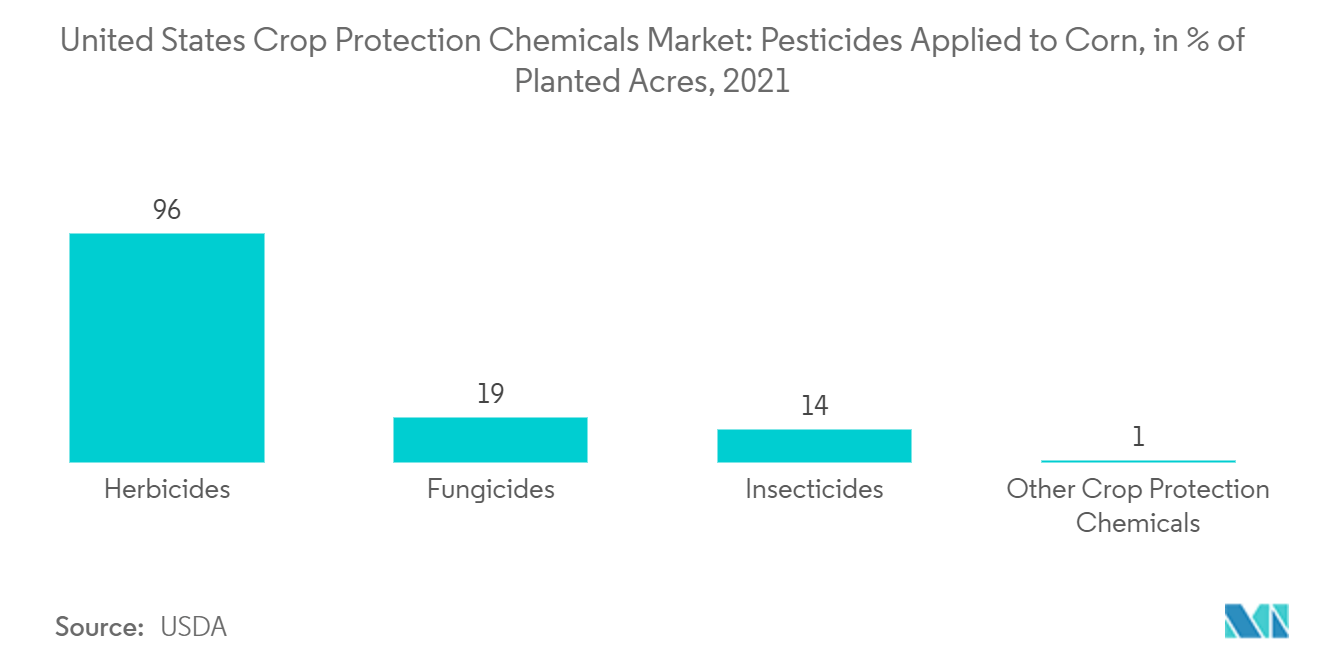
U.S. Crop Protection Chemicals Industry Overview
The United States Crop Protection Chemicals Market is highly consolidated, with major players occupying large market shares and competing fiercely with local players and private labels. The key players in the market include Bayer AG, BASF SE, Syngenta AG, Corteva Agriscience LLC, and FMC Corporation. Broadening the product portfolio by introducing new and innovative products into the market is the most adopted strategy by these companies. Along with innovations and expansions, investments in R&D and developing new formulas are likely to be crucial strategies in the coming years.
U.S. Crop Protection Chemicals Market Leaders
Bayer AG
BASF SE
Syngenta AG
Corteva Agriscience
FMC Corporation
*Disclaimer: Major Players sorted in no particular order
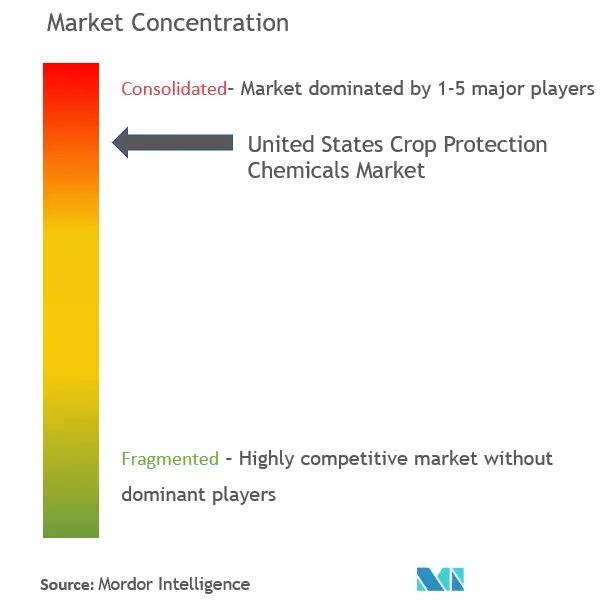
U.S. Crop Protection Chemicals Market News
- January 2023: Bayer collaborated with the agricultural biotech company Oerth Bio to develop the next generation of more sustainable crop protection products.
- May 2022: FMC launched ZironarTM bio fungicide/bionematicide, a new biological product. It offers early-season protection against critical fungal diseases and soil nematodes, as well as a biostimulant effect that helps boost yields and plant health. FMC broadened its investments in technology to ensure FMC has access to innovations that enhance its capabilities.
- April 2021: Corteva AgriScience launched the DuraCor herbicide for pastures and rangeland in the United States. DuraCor is expected to control more than 140 broadleaf weed species, as well as offer several anticipated features, such as low use rate and low odor formation.
U.S. Crop Protection Chemicals Market Report - Table of Contents
1. INTRODUCTION
1.1 Study Assumptions and Market Definition
1.2 Scope of the Study
2. RESEARCH METHODOLOGY
3. EXECUTIVE SUMMARY
4. MARKET DYNAMICS
4.1 Market Overview
4.2 Market Drivers
4.3 Market Restraints
4.4 Porter's Five Forces Analysis
4.4.1 Bargaining Power of Suppliers
4.4.2 Bargaining Power of Buyers
4.4.3 Threat of New Entrants
4.4.4 Threat of Substitute Products
4.4.5 Intensity of Competitive Rivalry
5. MARKET SEGMENTATION
5.1 Origin
5.1.1 Synthetic
5.1.2 Bio-based
5.2 Product Type
5.2.1 Herbicides
5.2.2 Fungicides
5.2.3 Insecticides
5.2.4 Nematicides
5.2.5 Other Crop Protection Chemicals
5.3 Application
5.3.1 Grains and Cereals
5.3.2 Pulses and Oilseeds
5.3.3 Commercial Crops
5.3.4 Fruits and Vegetables
5.3.5 Turf and Ornamentals
6. COMPETITIVE LANDSCAPE
6.1 Most Adopted Strategies
6.2 Market Share Analysis
6.3 Company Profiles
6.3.1 Bayer AG
6.3.2 Syngenta AG
6.3.3 Corteva Agriscience
6.3.4 BASF SE
6.3.5 FMC Corporation
6.3.6 Adama Americas Inc.
6.3.7 UPL Limited
6.3.8 Sumitomo Chemicals America Inc.
6.3.9 Marrone Bio Innovations Inc.
6.3.10 AMVAC Chemical Corporation
7. MARKET OPPORTUNITIES AND FUTURE TRENDS
U.S. Crop Protection Chemicals Industry Segmentation
Crop protection chemicals have been defined for the purposes of this report as commercially manufactured agrochemicals used to prevent crop destruction by pests, diseases, and weeds, thereby improving crop yield and quality. The United States Crop Protection Chemicals Market is Segmented by Origin into Synthetic and Bio-based, Product Type into Herbicides, Fungicides, Insecticides, Nematicides, and Other Crop Protection Chemicals, and Application into Grains and Cereals, Pulses and Oilseeds, Commercial Crops, Fruits and Vegetables, and Turfs and Ornamentals. The report offers the market size and forecasts in terms of value (USD billion) for all the above segments.
| Origin | |
| Synthetic | |
| Bio-based |
| Product Type | |
| Herbicides | |
| Fungicides | |
| Insecticides | |
| Nematicides | |
| Other Crop Protection Chemicals |
| Application | |
| Grains and Cereals | |
| Pulses and Oilseeds | |
| Commercial Crops | |
| Fruits and Vegetables | |
| Turf and Ornamentals |
U.S. Crop Protection Chemicals Market Research FAQs
What is the current United States Crop Protection Chemicals Market size?
The United States Crop Protection Chemicals Market is projected to register a CAGR of 3.9% during the forecast period (2023-2028).
Who are the key players in United States Crop Protection Chemicals Market?
Bayer AG, BASF SE, Syngenta AG, Corteva Agriscience and FMC Corporation are the major companies operating in the United States Crop Protection Chemicals Market.
U.S. Crop Protection Chemicals Industry Report
Statistics for the 2023 U.S. Crop Protection Chemicals market share, size and revenue growth rate, created by Mordor Intelligence™ Industry Reports. U.S. Crop Protection Chemicals analysis includes a market forecast outlook to 2028 and historical overview. Get a sample of this industry analysis as a free report PDF download.
